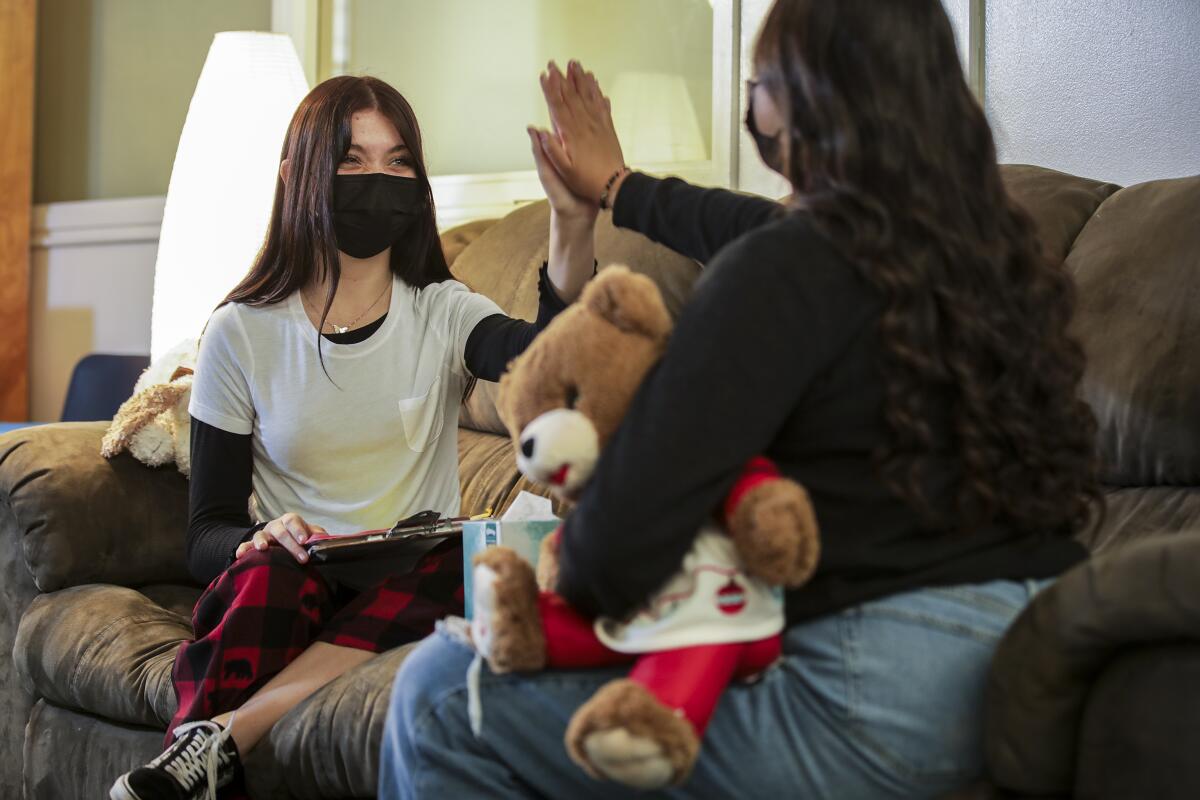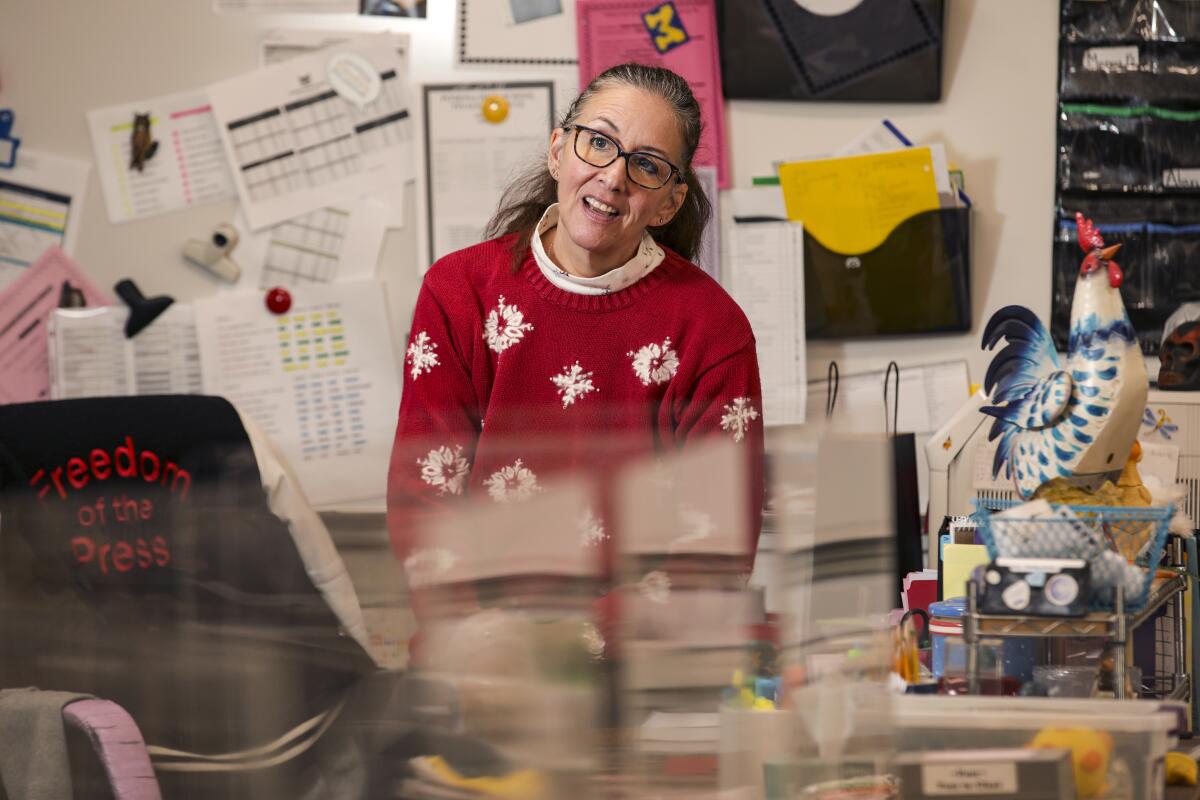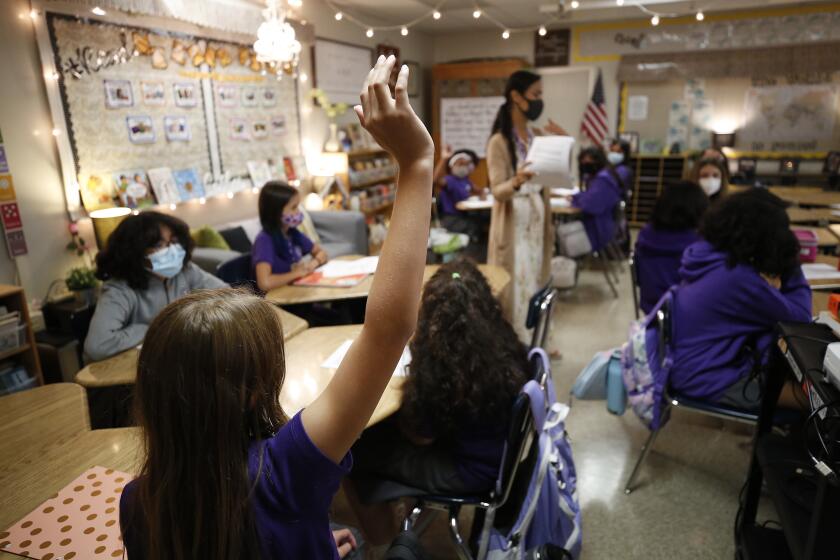Amid a youth mental health crisis, teens help one another

This is the Dec. 20, 2021, edition of the 8 to 3 newsletter about school, kids and parenting. Like what you’re reading? Sign up to get it in your inbox every Monday.
Every Wednesday, Thursday and Friday morning, 18-year-old Kelly Zamudio grabs her clipboard from the wellness center at Garey High School in Pomona and with a fellow peer counselor — they work in pairs — sets out to meet the first student on her list.
The three sit in the quad or lunch area, empty of teens when class is in session. They have about 15 minutes together, so they waste no time. “How are you doing this week?” Zamudio will ask. The student might start talking about a recent breakup or power struggles with their parents, or not being able to concentrate in class. Zamudio listens intently — the most vital part of her role — and with the other counselor helps the student come up with an action plan.
“They don’t know who I am, they don’t know anything about me, but the fact that they can confide in me and be vulnerable with me takes some weight off their shoulders,” said Zamudio, one of 50 peer counselors at the school of 1,700.
Collectively, teens are harboring a load of mental health challenges right now — so much so that U.S. Surgeon General Vivek H. Murthy issued a public health advisory on the crisis on Dec. 7, a rare warning and call to action as conditions were worsened by the pandemic.
Students are back in school but remain stressed out about COVID-19 and their mental health.
In the advisory, Murthy laid out dozens of suggestions for how educators, parents, community organizations and teens could step up and respond. Among his proposals to young people, he recommended that they “be a source of support for others.… For example, look into joining Youth Advisory Councils or mental health peer support programs in your community.”
At the center of discussion around the youth mental health crisis is what adults, particularly those at schools, can do to support struggling teens. What receives far less attention, though, is how young people can help one another.
An untold number of high schools across the U.S. already offer peer support programs and have done so for quite some time. Perhaps the most established kind of such support is peer counseling. In the 1970s, the late Palo Alto school psychologist Barbara Varenhorst helped pioneer the model, training students in active listening skills, and how and when they should refer a classmate to a school counselor.
High schools in Pomona were among those that adopted this model in the 1970s and ’80s, according to teacher Sheila Balk, who has led the peer counseling program at Pomona High School for 26 years. Those interested in joining peer counselor ranks must be in the 11th or 12th grade and undergo a rigorous interview process.
“There are two kinds of people in the program — people we need and people who need us,” she said. “People we need are usually gregarious or want to go into some kind of counseling profession. Others just need a place to belong; you can see that they have skills and talents that just haven’t been brought out yet. But basic counseling skills — anybody can learn them.”
This suggestion caught my attention. We talk a lot (and rightfully so) about how adults can support struggling youth but less often about how young people can help one another.
An untold number of high schools across the U.S. already facilitate peer support programs and have done so for quite some time. Perhaps the most established kind of such supports is peer counseling. In the 1970s, the late Palo Alto school psychologist Barbara Varenhorst helped pioneer the model, training students in active listening skills, and how and when they should refer a classmate to a school counselor.
High schools in Pomona were among those that adopted this model in the ’70s and ’80s, according to teacher Sheila Balk, who has led the peer counseling program at Pomona High School for 26 years. Those interested in joining peer counselor ranks must be in the 11th or 12th grade and undergo a rigorous interview process.
“There are two kinds of people in the program — people we need and people who need us,” she said. “People we need are usually gregarious or want to go into some kind of counseling profession. Others just need a place to belong; you can see that they have skills and talents that just haven’t been brought out yet. But basic counseling skills — anybody can learn them.”

Peer counselors are trained for four months (as part of a yearlong elective) before they meet with students. The curriculum, approved in 2019 by the University of California high school articulation team, stresses empathetic listening, deescalation, restorative justice practices and coping skills. The program, Balk said, is “ever-evolving and fluid to meet student needs.”
Students are referred to peer counselors by teachers and administrators, often because of discipline issues or because they’re struggling academically. But kids also seek out the service on their own. They’re free to leave class and go to the peer counseling hub — known as the wellness center — and talk to someone about why they’re upset or anxious. The center gets about five walk-ins a day.
There has been an especially high demand for services this school year because kids are overwhelmed, anxious and depressed.
“I’m writing school mental health referrals left and right. Quite frankly, this year, we’ve had more hospitalizations than I’ve ever seen,” Balk said. “We’re on call daily. We’re the first line of defense.”
Among those seeking peer counseling are teens who worked service jobs last year when school was remote while also taking care of their siblings. They are sophomores who behave like eighth-graders because they aren’t used to the expectations of high school, Balk said, adding that she has never seen so many panic attacks.
“We catch quite a few students who say they are suicidal,” said Gavin Santillan, the peer counseling program advisor at Garey High School. “Our counselors have spoken to kids who’ve had a plan and were on their way to execute a plan. Their last stop was peer counseling.”
Angeles Perez, a junior at Pomona High School, walked into the wellness center in September after having a panic attack in physics class. She didn’t understand the lesson that day, but the idea of raising her hand and asking for help was paralyzing. After a year in Zoom school, she feared she would look stupid in front of her classmates.
It had been a rough year for the 16-year-old: She had been stuck at home with parents who didn’t accept her queer identity and then she was diagnosed with Type 1 diabetes. When she felt sad, she used to turn to comfort foods like potato chips. Now, with this diagnosis, she couldn’t do that.
Perez felt like she had nowhere to turn. Sure, she had friends, but there was always a chance they’d gossip. When she first started meeting with her peer counselor, it was like a torrent of pain was being unleashed. She’d cry and cry. Mostly, the counselor would just listen.
“That’s what I needed, just someone to listen to me talk about how I felt without having their own opinions about it,” she said. Perez also saw an adult counselor at the school, and while she walked away from those interactions with valuable resources, she said, talking with another teen felt more comfortable in many ways.
“In peer counseling, I can talk however I want because I’m with another teenager,” Perez said. “I know they’ll get it.”
Given the heaviness of their meetings with students, counselors are trained to know their limits, Balk said. Sessions are confidential unless someone expresses intent to hurt themselves or others, or they are being hurt. In that case, the counselor must immediately speak to an advisor, who then reaches out to the school district’s mental health support team. At Garey High School, this is happening about twice a week this school year.
Experts cautioned that peer support programs should not be a substitute for actual therapy. Sometimes kids just need to vent. But many require sustained professional help. Unfortunately, the national average of caseloads for school counselors remains high, with 424 students per counselor for the 2019-20 school year; 250 students per counselor is the recommended ratio. Though an influx of pandemic relief funds has enabled schools to hire more mental health professionals, staffing those jobs has been more difficult than ever.
Still, peer programs can go a long way toward making students feel supported, said Margo Ross, managing director of communications and development at the Center for Supportive Schools. The New Jersey-based organization has assisted schools in establishing peer mentoring programs since 1979.
“You really can’t compete with the ability that young people have to relate to one another and influence one another,” Ross said. “We help young people do what they’re doing naturally, but we make sure they’re doing it in the most positive and helpful ways.”
An effective peer program should be accessible to as many students as possible, Ross added. For instance, the Center for Supportive Schools model requires every freshman to be paired with a peer leader who can help them navigate their first years of high school. Independent reviews of the program found that mentees demonstrated improved academic performance and social-emotional skills, as well as lower dropout rates.
In Ross’ view, a peer leader shouldn’t be a counselor — “It’s not the peer leader’s responsibility to do that,” she said — but more a listening ear, role model and liaison to adults who can help them with more serious problems.
The peer counseling model, although still prevalent, has evolved in many schools. Take L.A. Unified School District, which had more than 100 such programs in the late ’80s. Now only six high schools in the district, including Belmont Senior High School in Westlake and Crenshaw High School in Hyde Park, have opted for a program that trains students to mentor peers in the areas of mental, relational and reproductive health.
Peer counseling may no longer the dominant model of peer support in California because dedicated funding for it no longer exists, said Janis Ryan, an educational consultant and former facilitator of student assistant programs at Desert Sands Unified School District. Schools used to pay for their peer counseling programs with funding from the U.S. Department of Education’s Office of Safe and Drug-Free Schools funding, which was eliminated in 2011.
Such programs also have limited staying power because when new administrators come into schools, they may not value or understand their utility, Ryan said. These are the programs that are often cut if funding is needed elsewhere, as has been the case for many electives as education budgets have tightened. Meanwhile, peer mentoring programs like those associated with Friday Night Live are funded on an ongoing basis and are built into the state infrastructure.
For her part, Zamudio sees Garey High’s program as a priceless resource, one that has helped her personally. She applies her peer counseling skills, such as deep breathing exercises and listening to soothing music, when her anxiety spikes.
“The pandemic really shook a lot of us,” she said. “Even as peer counselors, there are days when we don’t feel our best. But being able to help other people feels so good.”
‘Test-to-stay,’ SATs and more
Many parents may be relieved to learn that the Centers for Disease Control and Prevention is endorsing “test-to-stay” policies — already used in many districts — that allow close contacts of students infected with the coronavirus to remain in classrooms if they test negative. Health officials decided to embrace the approach after finding that coronavirus infections did not increase in schools in the Chicago and Los Angeles areas when they used the strategy. Such policies enable districts to minimize learning disruptions caused by quarantines.
Cal State is poised to drop the SAT and ACT as an admissions requirement — a move that would follow the University of California’s elimination of the exams and further shake up the standardized testing landscape as hundreds of campuses across the nation shift away from the assessments. This would be a big deal, as Cal State educates nearly half a million students across its 23 campuses. Critics say standardized tests are an unfair admissions barrier to underrepresented students; decades of research show biased results based on race, income and parent education levels.
It’s harder than ever to get into the University of California and California State University, shutting many qualified students out of the world-class public university systems. A new report offers some solutions to this problem, including an increase in enrollment and financial incentives to attract students to less popular campuses, my colleague Teresa Watanabe writes.
Enjoying this newsletter?
Consider forwarding it to a friend, and support our journalism by becoming a subscriber.
Did you get this newsletter forwarded to you? Sign up here to get it in your inbox every week.
What else we’re reading
California’s first superintendent of equity lives in Philadelphia and has a separate job there, more than 2,500 miles away from the schools he advises as one of the highest-paid officials in the state Department of Education. Daniel Lee has almost no ties to California, a Politico investigation found.
K-12 enrollment across the U.S. is dropping for the second straight year. In L.A. alone, the student population declined by 17,000 students last school year and nearly 9,000 this year. NPR
San Diego Unified schools left more than $4 million in Title 1 funds unspent last year that could have been used for school counselors, supplies and more. Voice of San Diego
School boards are increasingly a site of agitation and activism across the U.S. Here’s how a dossier compiled on parents in Scottsdale, Ariz. turned into a national story. The New Yorker
I want to hear from you.
Have feedback? Ideas? Questions? Story tips? Email me. And keep in touch on Twitter.
Sign up for Essential California
The most important California stories and recommendations in your inbox every morning.
You may occasionally receive promotional content from the Los Angeles Times.





